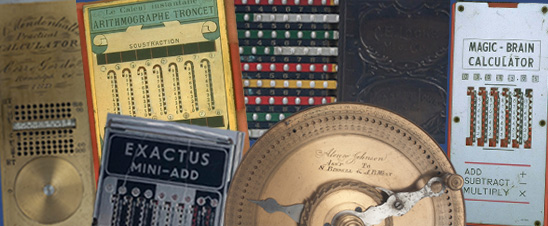This adder has a red plastic back and a gray steel front. There are six columns for entering numbers with a stylus, and a seventh notched band to record carries to a seventh digit. A set of seven openings above the bracket-shaped columns of the adder displays the result.
- Description
-
This adder has a red plastic back and a gray steel front. There are six columns for entering numbers with a stylus, and a seventh notched band to record carries to a seventh digit. A set of seven openings above the bracket-shaped columns of the adder displays the result. A zeroing bar is across the top. The plastic is shaped to hold the steel stylus.
-
The object is marked: MAGIC-BRAIN [/] CALCULATOR; ADD + [/] SUBTRACT - [/] MULTIPLY X; and: JAPAN. Instructions are stored separately. Compare to 1987.0375.01.
-
References: Popular Science, February, 1962, vol. 180, p. 20. This ad indicates that the Magic-Brain Calculator cost $.98 and was distributed from the Sunset Building, Beverly Hills, California.
-
P. Kidwell, “Adders Made and Used in the United States,” Rittenhouse, 8, (1994): pp. 78-96.
- Location
-
Currently not on view
- date made
-
1960
- distributor
-
Sunset House
- ID Number
-
1993.3058.01
- nonaccession number
-
1993.3058
- catalog number
-
1993.3058.01
